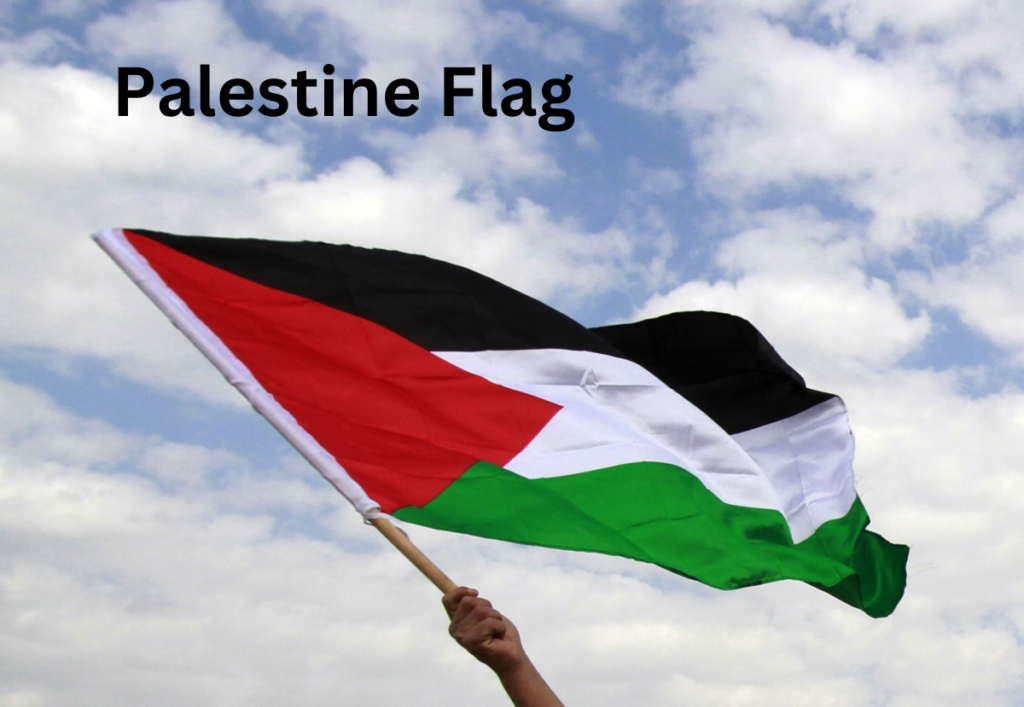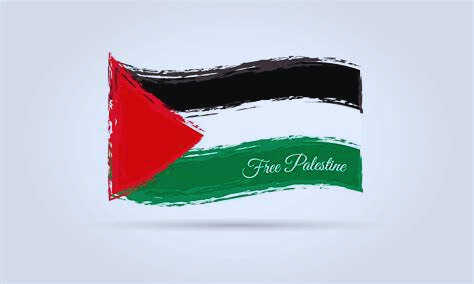The Palestine Flag, also known as ſalam Filasṭīn in romanized form, is a tricolor consisting of three equal horizontal stripes, namely black, white, and green, arranged from top to bottom, and topped with a red triangle that extends from the hoist. It signifies the Palestinian people and the State of Palestine and features the pan-Arab colors, which were initially mixed in the current manner during the Arab Revolt of 1916.
Ask the lofty, ascending spears about our goals.
Show us the swords; did we give up?
We are a band; integrity stops our spirits.
Those who won’t damage us, of starting with harm
Our actions are white, and our struggles are black.
Our swords are red, our fields green.
(The poet Safi al-Din al-Hili).
place of origin
The Arab Revolt is the name given to the period during which several Arab tribes in the region banded together to oppose the Ottomans, who had been governing various regions of the region for centuries, during World War I. The Arabs’ desire for their own nation under Arab leadership was one of the primary drivers of this uprising.
Hussein bin Ali, the Sherif (chief) of Mecca at the time, created a unique flag just for this uprising. The purpose of this flag was to symbolize their unity and defense of their own nation. It was similar to the current Palestine Flag in that it featured three stripes—one each of black, white, and green—though the stripes are now arranged differently. This flag came to represent their fight for independence.
At least since the late 1930s, Palestine has flown a modified version of this flag (with the stripes rearranged), which the Palestine Liberation Organization (PLO) formally recognized as the national flag of the Palestinian people in 1964.
The National Council of Palestine drew up the National Charter at its first meeting on May 28, 1964. Article 27 said that Palestine would have an oath, an anthem, and a flag with the following colors: green, white, black, and red triangle. The Palestine Liberation Organization designated the flag as the national flag of the state of Palestine on November 15, 1988.
September 30, 2015, saw the Palestine Flag fly was flown with the flags of 193 other member states at the UN headquarters for the first time. Mahmoud Abbas, the president of Palestine, proclaimed September 30 to be Palestine Flag Day later that day.
The Significance of the Palestine Flag:

RED:
Following the death of Caliph Uthman III, the Khawarij became the first Islamic faction to organize the first republican party in the early history of Islam. The red flag served as their emblem. The red flag, which became the emblem of the Islamic rulers of Andalusia, was carried by Arab tribes that took part in the conquest of North Africa and Andalusia (756-1355). Red now represents the Hashemites, who are the descendants of the Prophet, and the Ashrafs of the Hijaz.
The current flag was created by Sharif Hussein in June 1916 as the Arab Revolt’s flag. In 1917, the Palestinian people hoisted it as the Arab National movement’s banner. The Arab Ba’ath Party saw the flag in 1947 and believed it to be a representation of the Arab people’s liberation and solidarity. During the 1948 Palestinian conference in Gaza, the Palestinian people re-adopted the flag. The Arab League acknowledged the flag as belonging to the Palestinian people. At the 1964 Palestinian conference in Jerusalem, it was further supported by the PLO, the Palestinians’ representative.
BLACK:
Muhammad, the prophet (570–632)
When Islam emerged in the seventh century and Mecca was freed, two flags—one white and one black—were flown. “There is no god but God (Allah), and Muhammad is the Prophet of God,” was written on the white flag.
Before the advent of Islam, the black banner represented retaliation. It has to do with the color of the headgear soldiers wore when they went into combat. During Friday prayers, there were both black and white flags flown inside the mosque.
During the Abbasid Dynasty (750–1258), which was based in Baghdad, black was the color of mourning for the deaths of the Prophet’s relatives and as a tribute to the Karbala Battle.
WHITE:
Damascus during the Umayyad Dynasty (661–750) The ninety-year rule of the Umayyads
years, adopting the color white as their mourning color instead of black in order to stand apart from the Abbasids and to commemorate the Prophet’s first war at Badr. The Umayyad state’s founder, Mu’awia Ibn Abi Sufian (661–750), crowned himself Caliph of Jerusalem.
GREEN:
North Africa’s Fatimid Dynasty (909–1171)
Abdullah Al-Mahdi established the Fatimid Dynasty in Morocco, which eventually came to dominate all of North Africa.
They chose the color green to represent their loyalty to Ali, the cousin of the Prophet, who resisted an attempt on his life by being covered in a green coverlet in lieu of the Prophet.
Other flags of Pan-Arab:
The flag is comparable to those of the short-lived Arab Federation of Iraq and Jordan (which included an equilateral triangle at the hoist) and Syria’s Ba’ath Party, which employs the same forms and colors but a 2:3 ratio as opposed to Palestine‘s 1:2. It is also comparable to the flags of Jordan, Western Sahara, and Sudan, which are all inspired by the Great Arab Revolt (1916–1918) against Ottoman control. The geometric form of the Arab Revolt’s flag was the same, but the colors were positioned differently—white was on the bottom instead of in the center.
for more information visit our Homepage



